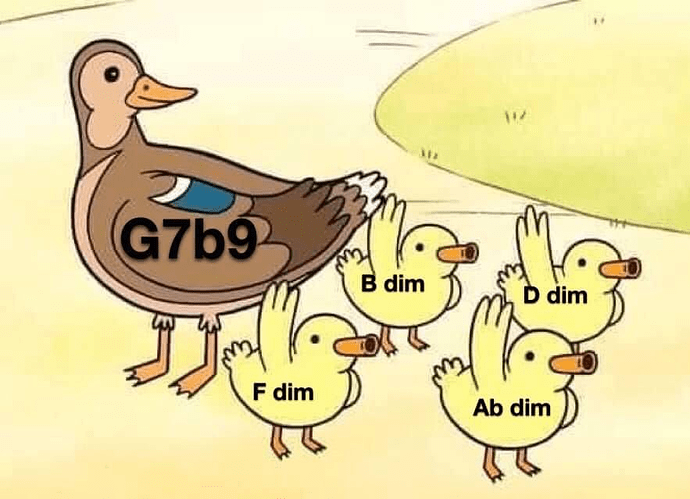In the context of a chord progression in a harmonic minor key, when do the stacked diminished 7 arpeggios that YJM uses so regularly theoretically fit in? I.e. over what chords?
Harmonic minor is pretty unique in its harmony, hence its name.
But, suffice to say, the V and vii° chords of harmonic minor are technically one and the same.
Let’s take the key of A minor.
The diatonic chords in a minor key are represented with Roman numerals. Lower case is minor, upper case is major, and the degree symbol indicates a diminished chord:
i ii° bIII iv V bVI vii°.
Now, let’s add chords to this to have it make more sense:
Amin, Bdim, C, Dmin, E, F, G#dim.
Let’s add our next tier of harmony, 7th chords:
Amin(maj7), Bmin7b5, Cmaj7#5, Dmin7, E7, Fmaj7, G#dim7.
Now, let’s look at the V and vii° chords more closely.
E7 contains these notes:
E G# B D.
G#dim7 contains these notes:
G# B D F.
Now, if we look at the V chord one more time, and add our chord extensions to it, we end up creating an E7b9 chord, which contains these notes:
E G# B D F.
In other words, the V and vii° of harmonic minor are one and the same in harmonic minor.
Now, let’s look more closely at the vii° chord.
It’s G#dim7, and dim7 chords are chords that are built by stacking minor thirds on top of each other to create these intervals:
1 b3 b5 bb7.
Meaning, all you have to do on guitar is memorize one shape for a dim7 chord, then move it up and down by three frets, and all you’ll be doing is playing the same arpeggio, just in different inversions.
Let’s try it with the G#dim7 chord.
G#dim7 in root position is:
G# B D F.
G#dim7 in first inversion, commonly written as G#dim7/B, is:
B D F G#.
G#dim7 in second inversion, commonly written as G#dim7/D, is:
D F G# B.
G#dim7 in third inversion, commonly written as G#dim7/F, is:
F G# B D.
What this means, realistically, is if you’re improvising in A harmonic minor, and you land on any F, G#, B, or D note, that means you can move up or down three frets, and still stay within harmonic minor, and if you build a dim7 chord off them by just stacking minor thirds on them, that means you’ll basically be playing the vii° chord of harmonic minor.
Cool, eh?
As far as when to use it, that comes down to some good ol’ fashioned functional harmony as it applies to minor keys.
Let’s do a quick crash course on functional harmony really quick.
In any key, major or minor, there’s going to be chords that sound the most stable and consonant. These are your tonic function chords.
There’s also going to be chords that are very unstable, tense, and dissonant. These are your dominant function chords, and their job is to reaffirm the key. Thus, that’s why the G# note in A harmonic minor has a strong tendency to resolve up to the A note.
There’s also going to be chords that aren’t as stable as tonic function chords, but not as dissonant as dominant function chords, and in most circumstances, they set up the dominant function chords. These are called your predominant function chords.
Now, let’s refamiliarize ourselves with the diatonic chords of a minor key:
i ii° bIII iv V bVI vii°.
Now, here’s each chord categorized by their functions.
Tonic Function: i, bIII, bVI.
Dominant Function: V and vii°.
Predominant Function: ii° and iv.
Now, since E7 and G#dim7 are your V and vii° chords respectively, they’re dominant function chords by default. They’ll sound the most dissonant and tense, and have a strong tendency to move towards the i chord, Amin.
You can hear how satisfying moving from E7 to Amin sounds, which creates a perfect cadence.
But, since we now know that technically speaking, V and vii° chords are one and the same in harmonic minor, that means we can use our diminished arpeggios over the V and vii° chords.
If we play a G#dim7 chord over an E chord, it’s not going to sound out of place, in fact, together, the two chords will both imply the sound of E7b9.
But, a personal tip, in harmonic minor, your dim7 chord occurs on the vii°, a dominant function chord, and you can use it in place of the V chord because it sounds more evil.
In conclusion, in harmonic minor, a diminished arpeggio can be used over the V and vii° chords in harmonic minor, because technically speaking, they contain the same notes, and to boot, they serve the same function, and that’s a dominant function.
Hope this helps!
Cheers!







